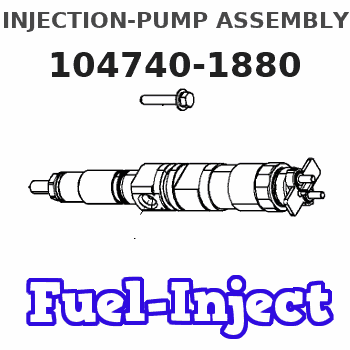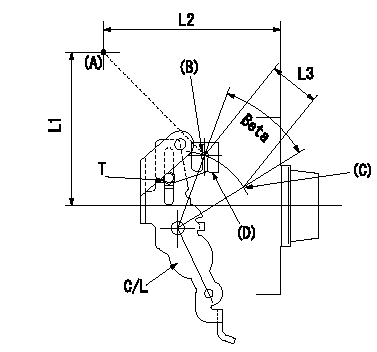Information injection-pump assembly
ZEXEL
104740-1880
1047401880
ISUZU
8970255450
8970255450

Rating:
Cross reference number
ZEXEL
104740-1880
1047401880
ISUZU
8970255450
8970255450
Zexel num
Bosch num
Firm num
Name
Calibration Data:
Adjustment conditions
Test oil
1404 Test oil ISO4113orSAEJ967d
1404 Test oil ISO4113orSAEJ967d
Test oil temperature
degC
45
45
50
Nozzle
105780-0060
Bosch type code
NP-DN0SD1510
Nozzle holder
105780-2150
Opening pressure
MPa
13
13
13.3
Opening pressure
kgf/cm2
133
133
136
Injection pipe
157805-7320
Injection pipe
Inside diameter - outside diameter - length (mm) mm 2-6-450
Inside diameter - outside diameter - length (mm) mm 2-6-450
Joint assembly
157641-4720
Tube assembly
157641-4020
Transfer pump pressure
kPa
20
20
20
Transfer pump pressure
kgf/cm2
0.2
0.2
0.2
Direction of rotation (viewed from drive side)
Right R
Right R
Injection timing adjustment
Pump speed
r/min
1250
1250
1250
Average injection quantity
mm3/st.
49.1
48.6
49.6
Difference in delivery
mm3/st.
3.5
Basic
*
Oil temperature
degC
50
48
52
Injection timing adjustment_02
Pump speed
r/min
500
500
500
Average injection quantity
mm3/st.
49.9
49.9
49.9
Oil temperature
degC
48
46
50
Injection timing adjustment_03
Pump speed
r/min
1250
1250
1250
Average injection quantity
mm3/st.
49.1
48.1
50.1
Difference in delivery
mm3/st.
3.5
Basic
*
Oil temperature
degC
50
48
52
Injection timing adjustment_04
Pump speed
r/min
2150
2150
2150
Average injection quantity
mm3/st.
47.6
47.6
47.6
Oil temperature
degC
52
50
54
Injection quantity adjustment
Pump speed
r/min
2500
2500
2500
Average injection quantity
mm3/st.
15.4
12.4
18.4
Difference in delivery
mm3/st.
4.5
Basic
*
Oil temperature
degC
55
52
58
Injection quantity adjustment_02
Pump speed
r/min
2850
2850
2850
Average injection quantity
mm3/st.
5
Oil temperature
degC
55
52
58
Injection quantity adjustment_03
Pump speed
r/min
2500
2500
2500
Average injection quantity
mm3/st.
15.4
12.4
18.4
Difference in delivery
mm3/st.
4.5
Oil temperature
degC
55
52
58
Governor adjustment
Pump speed
r/min
425
425
425
Average injection quantity
mm3/st.
10.5
8.5
12.5
Difference in delivery
mm3/st.
2
Basic
*
Oil temperature
degC
48
46
50
Governor adjustment_02
Pump speed
r/min
425
425
425
Average injection quantity
mm3/st.
10.5
8.5
12.5
Difference in delivery
mm3/st.
2
Oil temperature
degC
48
46
50
Timer adjustment
Pump speed
r/min
100
100
100
Average injection quantity
mm3/st.
55
55
75
Basic
*
Oil temperature
degC
48
46
50
Remarks
Full
Full
Timer adjustment_02
Pump speed
r/min
100
100
100
Average injection quantity
mm3/st.
55
55
85
Oil temperature
degC
48
46
50
Speed control lever angle
Pump speed
r/min
425
425
425
Average injection quantity
mm3/st.
0
0
0
Oil temperature
degC
48
46
50
Remarks
Magnet OFF at idling position
Magnet OFF at idling position
0000000901
Pump speed
r/min
1250
1250
1250
Overflow quantity
cm3/min
420
290
550
Oil temperature
degC
50
48
52
Stop lever angle
Pump speed
r/min
1750
1750
1750
Pressure
kPa
588
568
608
Pressure
kgf/cm2
6
5.8
6.2
Basic
*
Oil temperature
degC
50
48
52
Stop lever angle_02
Pump speed
r/min
1750
1750
1750
Pressure
kPa
588
559
617
Pressure
kgf/cm2
6
5.7
6.3
Basic
*
Oil temperature
degC
50
48
52
0000001101
Pump speed
r/min
1750
1750
1750
Timer stroke
mm
4.2
4
4.4
Basic
*
Oil temperature
degC
50
48
52
_02
Pump speed
r/min
600
600
600
Timer stroke
mm
0
0
0
Oil temperature
degC
50
48
52
_03
Pump speed
r/min
1010
1010
1010
Timer stroke
mm
0.5
0.5
Oil temperature
degC
50
48
52
_04
Pump speed
r/min
1250
1250
1250
Timer stroke
mm
2
1.6
2.4
Oil temperature
degC
50
48
52
_05
Pump speed
r/min
1750
1750
1750
Timer stroke
mm
4.2
4
4.4
Basic
*
Oil temperature
degC
50
48
52
_06
Pump speed
r/min
2150
2150
2150
Timer stroke
mm
5.9
5.4
6.4
Oil temperature
degC
52
50
54
0000001201
Max. applied voltage
V
8
8
8
Test voltage
V
13
12
14
0000001401
Pump speed
r/min
1750
1750
1750
Average injection quantity
mm3/st.
35
34
36
Timer stroke TA
mm
3.5
3.3
3.7
Basic
*
Oil temperature
degC
50
48
52
_02
Pump speed
r/min
1750
1750
1750
Average injection quantity
mm3/st.
35
34
36
Timer stroke TA
mm
3.5
3.1
3.9
Basic
*
Oil temperature
degC
50
48
52
_03
Pump speed
r/min
1750
1750
1750
Average injection quantity
mm3/st.
25
24
26
Timer stroke TA
mm
2.6
2
3.2
Oil temperature
degC
50
48
52
Timing setting
K dimension
mm
3.3
3.2
3.4
KF dimension
mm
5.8
5.7
5.9
MS dimension
mm
0.9
0.8
1
Pre-stroke
mm
0.2
0.18
0.22
Control lever angle alpha
deg.
-2
-6
2
Control lever angle beta
deg.
38
33
43
Test data Ex:
0000001801 A/T PLATE ADJUSTMENT

A/T plate adjustment
1. Turn the control lever from the idle position (B) to the Full speed position (C)
2. Adjust the A/T plate (D) so that (A)(C) - (A)(B) = L3, then fix.
----------
L3=33+-0.5mm
----------
L1=95.5mm L2=109.5mm L3=33+-0.5mm T=3.5~5N-m(0.35~0.5kgf-m)
----------
L3=33+-0.5mm
----------
L1=95.5mm L2=109.5mm L3=33+-0.5mm T=3.5~5N-m(0.35~0.5kgf-m)
Information:
White Smoke
Possible Causes/CorrectionsCold Outside Temperatures
When the air outside is cold, the cylinder temperature is cooler. Not all the fuel will burn in the cylinders. The fuel which does not burn comes out the exhaust as white smoke. White smoke is normal in cold temperatures until the engine operates long enough to become warm. There will be less white smoke if No. 1 diesel fuel is used.Long Idle Periods
When an engine runs at idle speed for a long period of time, the cylinders cool and all of the fuel does not burn. Do not idle an engine for a long period of time. Stop an engine when it is not in use. If long idle periods are necessary, use No. 1 diesel fuel.Engine Operating Temperature Too Low
This can cause white smoke on startup. If the smoke is slow to clear from the exhaust, check and make a replacement of the thermostat if needed.Low Quality Fuel
Test the engine using fuec according to recommendations by Caterpillar Inc. For more information see Special Instruction, Form No. SEHS7067, Fuel Recommendations For Caterpillar Diesel Engines.Air In Fuel System
With air in the fuel system, the engine will normally be difficult to start, run rough, and release a large amount of white smoke. If the engine will not start, loosen a fuel injection line nut at the through the head adapter and crank the engine until fuel comes out. Tighten the fuel line nut. Start the engine. If the engine still does not run smooth or releases a large amount of white smoke, loosen the fuel line nuts one at a time at the through head adapters until the fuel that comes out is free of air. Tighten the fuel line nuts. If the air cannot be removed in this way, put 35 kPa (5 psi) of air pressure to the fuel tank.
Do not use more than 55 kPa (8 psi) of air pressure in the fuel tank or damage to the tank may result.
Check for leakage at the connections between the fuel tank and the fuel transfer pump. If leaks are found, tighten the connections or replace the lines. If there are no visual leaks, remove the fuel supply line from the tank and connect it to an outside fuel supply. If this corrects the problem, the suction line (standpipe) inside the fuel tank has a leak.Fuel Injection Timing Not Correct
Check and make necessary adjustments as in Testing and Adjusting section of this Service Manual.Valve Adjustment Not Correct
Check and make necessary adjustments as in Testing and Adjusting section of this Service Manual. Intake valve clearance is 0.38 mm (.015 in) and exhaust valve clearance is 0.76 mm (.030 in).Bad Fuel Nozzle(s)
Bad fuel nozzles will normally cause the engine to "misfire" and run rough, but can cause too much smoke with the engine still running smooth. Remove the fuel nozzles and test as in Testing and Adjusting section of this Service Manual.Misfiring Cylinder(s)
See Misfiring And Running Rough.Coolant Leakage Into Combustion Chamber
Coolant in the combustion chamber can
Possible Causes/CorrectionsCold Outside Temperatures
When the air outside is cold, the cylinder temperature is cooler. Not all the fuel will burn in the cylinders. The fuel which does not burn comes out the exhaust as white smoke. White smoke is normal in cold temperatures until the engine operates long enough to become warm. There will be less white smoke if No. 1 diesel fuel is used.Long Idle Periods
When an engine runs at idle speed for a long period of time, the cylinders cool and all of the fuel does not burn. Do not idle an engine for a long period of time. Stop an engine when it is not in use. If long idle periods are necessary, use No. 1 diesel fuel.Engine Operating Temperature Too Low
This can cause white smoke on startup. If the smoke is slow to clear from the exhaust, check and make a replacement of the thermostat if needed.Low Quality Fuel
Test the engine using fuec according to recommendations by Caterpillar Inc. For more information see Special Instruction, Form No. SEHS7067, Fuel Recommendations For Caterpillar Diesel Engines.Air In Fuel System
With air in the fuel system, the engine will normally be difficult to start, run rough, and release a large amount of white smoke. If the engine will not start, loosen a fuel injection line nut at the through the head adapter and crank the engine until fuel comes out. Tighten the fuel line nut. Start the engine. If the engine still does not run smooth or releases a large amount of white smoke, loosen the fuel line nuts one at a time at the through head adapters until the fuel that comes out is free of air. Tighten the fuel line nuts. If the air cannot be removed in this way, put 35 kPa (5 psi) of air pressure to the fuel tank.
Do not use more than 55 kPa (8 psi) of air pressure in the fuel tank or damage to the tank may result.
Check for leakage at the connections between the fuel tank and the fuel transfer pump. If leaks are found, tighten the connections or replace the lines. If there are no visual leaks, remove the fuel supply line from the tank and connect it to an outside fuel supply. If this corrects the problem, the suction line (standpipe) inside the fuel tank has a leak.Fuel Injection Timing Not Correct
Check and make necessary adjustments as in Testing and Adjusting section of this Service Manual.Valve Adjustment Not Correct
Check and make necessary adjustments as in Testing and Adjusting section of this Service Manual. Intake valve clearance is 0.38 mm (.015 in) and exhaust valve clearance is 0.76 mm (.030 in).Bad Fuel Nozzle(s)
Bad fuel nozzles will normally cause the engine to "misfire" and run rough, but can cause too much smoke with the engine still running smooth. Remove the fuel nozzles and test as in Testing and Adjusting section of this Service Manual.Misfiring Cylinder(s)
See Misfiring And Running Rough.Coolant Leakage Into Combustion Chamber
Coolant in the combustion chamber can